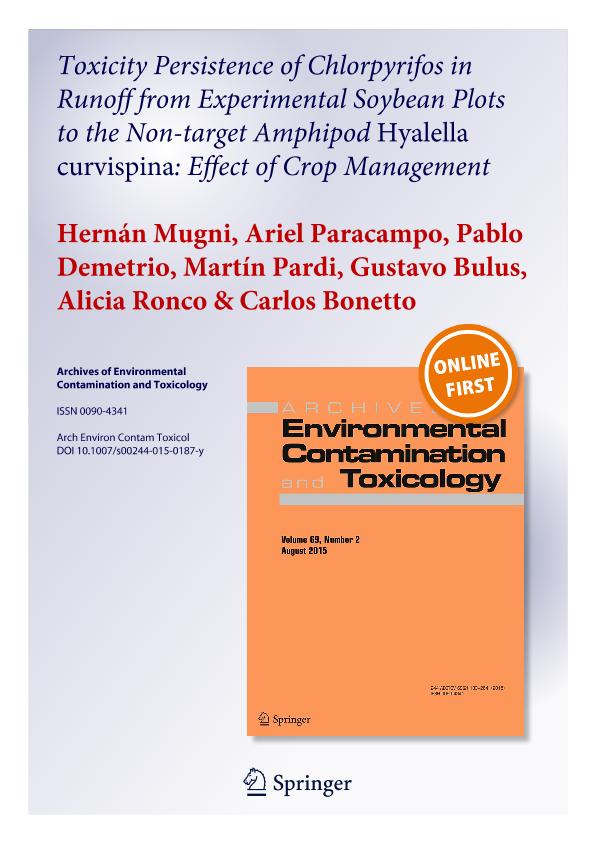Mostrar el registro sencillo del ítem
dc.contributor.author
Mugni, Hernan Diego

dc.contributor.author
Paracampo, Ariel Hernán

dc.contributor.author
Demetrio, Pablo Martin

dc.contributor.author
Pardi, Martín
dc.contributor.author
Bulus Rossini, Gustavo Daniel

dc.contributor.author
Ronco, Alicia Estela

dc.contributor.author
Bonetto, Carlos Alberto

dc.date.available
2017-08-07T18:02:30Z
dc.date.issued
2015-07-04
dc.identifier.citation
Mugni, Hernan Diego; Paracampo, Ariel Hernán; Demetrio, Pablo Martin; Pardi, Martín; Bulus Rossini, Gustavo Daniel; et al.; Toxicity Persistence of Chlorpyrifos in Runoff from Experimental Soybean Plots to the Non-target Amphipod Hyalella curvispina: Effect of Crop Management; Springer; Archives of Environmental Contamination and Toxicology; 70; 2; 4-7-2015; 257–264
dc.identifier.issn
0090-4341
dc.identifier.uri
http://hdl.handle.net/11336/21950
dc.description.abstract
Toxicity persistence to the non-target amphipod Hyalella curvispina in runoff events following chlorpyrifos applications to soy experimental plots was compared in conventional and no-till management. Two application scenarios were compared; an early season application with the soil almost bare and a late season application after the foliage had attained complete soil cover. H. curvispina was exposed to chlorpyrifos using two different test systems, a short-term (48 h) runoff water exposure and a long-term (10 d) soil exposure.Both commonly used crop management practices for soybean production resulted in runoff toxicity following pesticide applications and represent a toxicity risk for adjacent inland waters. Toxicity persistence was longer after the earlier than the late season application, likely because of higher volatilization and photodecomposition losses from the soy canopy than from the soil. For the early season application, toxicity persisted longer in the no-till plots than in the conventional tillage plots. Suspended matter was higher in the conventional treatment. Chlorpyrifos sorption to suspended matter likely contributed to the shorter persistence. For the late season application, toxicity persisted longer in the conventional treatment. The causes remain conjectural. The soil organic carbon content was higher in the no-till treatment. Sorption to organic matter might have contributed to the shorter chlorpyrifos toxicity persistence in no-till management. Late applications are more frequent and prevail longer throughout the soy growing season. Overall, the no-till management practice seems preferably because shorter toxicity persistence in runoff represents a lower environmental risk for the adjacent inland waters.
dc.format
application/pdf
dc.language.iso
eng
dc.publisher
Springer

dc.rights
info:eu-repo/semantics/openAccess
dc.rights.uri
https://creativecommons.org/licenses/by-nc-sa/2.5/ar/
dc.subject
Persistence
dc.subject
Runoff
dc.subject
Toxicity
dc.subject
Soy
dc.subject.classification
Bioquímica y Biología Molecular

dc.subject.classification
Ciencias Biológicas

dc.subject.classification
CIENCIAS NATURALES Y EXACTAS

dc.title
Toxicity Persistence of Chlorpyrifos in Runoff from Experimental Soybean Plots to the Non-target Amphipod Hyalella curvispina: Effect of Crop Management
dc.type
info:eu-repo/semantics/article
dc.type
info:ar-repo/semantics/artículo
dc.type
info:eu-repo/semantics/publishedVersion
dc.date.updated
2017-05-02T18:17:01Z
dc.journal.volume
70
dc.journal.number
2
dc.journal.pagination
257–264
dc.journal.pais
Alemania

dc.journal.ciudad
Berlín
dc.description.fil
Fil: Mugni, Hernan Diego. Consejo Nacional de Investigaciones Científicas y Técnicas. Centro Científico Tecnológico Conicet - La Plata. Instituto de Limnología "Dr. Raúl A. Ringuelet". Universidad Nacional de La Plata. Facultad de Ciencias Naturales y Museo. Instituto de Limnología; Argentina
dc.description.fil
Fil: Paracampo, Ariel Hernán. Consejo Nacional de Investigaciones Científicas y Técnicas. Centro Científico Tecnológico Conicet - La Plata. Instituto de Limnología "Dr. Raúl A. Ringuelet". Universidad Nacional de La Plata. Facultad de Ciencias Naturales y Museo. Instituto de Limnología; Argentina
dc.description.fil
Fil: Demetrio, Pablo Martin. Universidad Nacional de la Plata. Facultad de Ciencias Exactas. Departamento de Química. Centro de Investigaciones del Medio Ambiente; Argentina
dc.description.fil
Fil: Pardi, Martín. Universidad Nacional de La Plata. Facultad de Ciencias Agrarias y Forestales; Argentina
dc.description.fil
Fil: Bulus Rossini, Gustavo Daniel. Universidad Nacional de la Plata. Facultad de Ciencias Exactas. Departamento de Química. Centro de Investigaciones del Medio Ambiente; Argentina
dc.description.fil
Fil: Ronco, Alicia Estela. Universidad Nacional de la Plata. Facultad de Ciencias Exactas. Departamento de Química. Centro de Investigaciones del Medio Ambiente; Argentina. Consejo Nacional de Investigaciones Científicas y Técnicas; Argentina
dc.description.fil
Fil: Bonetto, Carlos Alberto. Consejo Nacional de Investigaciones Científicas y Técnicas. Centro Científico Tecnológico Conicet - La Plata. Instituto de Limnología "Dr. Raúl A. Ringuelet". Universidad Nacional de La Plata. Facultad de Ciencias Naturales y Museo. Instituto de Limnología; Argentina
dc.journal.title
Archives of Environmental Contamination and Toxicology

dc.relation.alternativeid
info:eu-repo/semantics/altIdentifier/url/https://link.springer.com/article/10.1007/s00244-015-0187-y
dc.relation.alternativeid
info:eu-repo/semantics/altIdentifier/doi/http://dx.doi.org/10.1007/s00244-015-0187-y
Archivos asociados
